Highlights from the New 117th Congress Legislative Effectiveness Scores
By Craig Volden and Alan Wiseman, Co-Directors, Center for Effective Lawmaking
The Center for Effective Lawmaking (CEL) is pleased to announce the release of the Legislative Effectiveness Scores (LES) for the recently completed 117th Congress (2021-23). As in all previous releases, the scores are based on the combination of fifteen metrics regarding the bills that each member of Congress sponsors, how far they move through the lawmaking process, and how substantial their policy proposals are. The scores are normalized to an average value of 1.0 in both the House and the Senate. More on our methodology can be found here.
Each lawmaker’s LES can be found here. For each Representative and Senator, we also identify a Benchmark Score, based on the average effectiveness of lawmakers who share that legislator’s majority- or minority-party status, level of seniority, and chair position on a committee or subcommittee. Controlling for these considerations is important in order to describe lawmakers on a more level playing field. For example, in the 117th House, minority-party lawmakers had an average LES of 0.58, compared to 1.40 for majority-party members, while committee chairs had an average of 2.55. In the more-egalitarian Senate, those averages were 0.77 in the minority party, 1.23 in the majority party, and 1.51 among committee chairs.
We then label each lawmaker as “Exceeding Expectations” for those outperforming their benchmark by 50% or more, “Below Expectations” for those below 50% of their benchmark, and “Meeting Expectations” for those scoring near their benchmark.
Finally, within each party, we rank each member from first to last. This ranking is used to generate the Top Ten lists highlighted in the tables below. Given the strong benefit from being in the majority party, ranking the entire Congress together would be inappropriate. But these comparisons within each party are quite informative.
Highly Effective Democratic Lawmakers in the 117th House of Representatives
The following table identifies the top ten highest-scorers in the 117th House of Representatives among majority-party Democrats. Unsurprisingly, given the power of committee and subcommittee chairs, nine of the top ten held such important positions.
Topping our list is Rep. Gerald Connolly of Virginia, with a Legislative Effectiveness Score more than seven times the average member of the House. Rep. Connolly was Chair of the Government Operations subcommittee of the House Oversight and Reform Committee in the 117th Congress, where he was serving his 7th term. He sponsored 51 bills, 11 of which passed the House, and 3 of which became law as standalone measures. In contrast, the average member of the House sponsored 21 bills, with only one law produced for every two House members. In addition to sponsoring the Consolidated Appropriations Act of 2023, Rep. Connolly was the sponsor of the First Responder Fair RETIRE Act, which allowed disabled first responders to collect federal retirement benefits in a manner equivalent to non-disabled federal first responders. Rep. Connolly was also the sponsor of two bills, the Enhanced Whistleblower Engagement Act, and the FedRAMP Authorization Act, that had their language substantially incorporated into the James M. Inhofe National Defense Authorization Act for Fiscal Year 2023, which was signed into law in December 2022.
While he used his position as committee chair to advance numerous pieces of legislation in the 117th Congress, Rep. Connolly has been an effective lawmaker throughout his career, even as a rank-and-file Representative, and when in the minority party. For example, he was in our “Exceeds Expectations” grouping in five of the seven Congresses in which he served, beginning with his third term in Congress, and every term thereafter (including the 117th Congress).
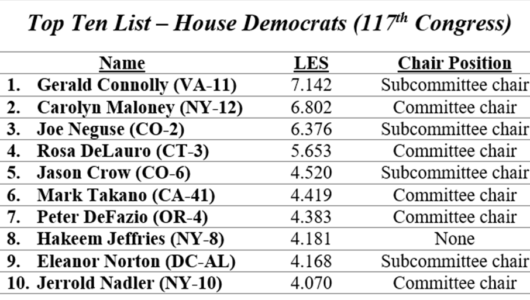
Coming in as the second-most effective lawmaker was Rep. Carolyn Maloney of New York, who chaired the House Oversight and Reform Committee. She sponsored 92 bills, with more than a third of them (unsurprisingly) being related to issues of government operations, ranging from whistleblower protections to the administration of the U.S. census. While eight of her bills passed the House, and the language in one of her bills was incorporated into the National Defense Authorization Act, only two of Rep. Maloney’s bills directly became law; and the most substantial of these bills, the Postal Service Reform Act of 2022, engaged with a policy area that fell squarely within her committee’s jurisdiction. Similar to Rep. Connolly, Rep. Maloney had also been highly effective when in the minority party in previous congresses. In fact, across the 15 congresses in which she served, Rep. Maloney was in our “Exceeds Expectations” grouping for 12 of them, including her final term in the 117th Congress. Due to redistricting, Rep. Maloney was matched up against another top-ten Democrat (Rep. Jerrold Nadler) in the 2022 primary, which Nadler won.
Rep. Joe Neguse of Colorado was the third-highest scoring Democratic lawmaker in the 117th Congress, where he served as the chair of the National Parks, Forest, and Public Lands subcommittee of the House Natural Resources Committee. In finding his way onto the top-10 most effective Democratic lawmakers in the House, Rep. Neguse continues a pattern of achievement that he established in the preceding 116th Congress, when he was one of only two freshmen members to be listed as among the top-10 most effective Democratic lawmakers in that Congress. In the 117th Congress, Rep. Neguse introduced 89 bills, 3 of which ultimately became law. His sponsored bills engaged with a wide range of policy areas, although most dealt with matters pertaining to public lands and natural resources (areas of interest to his home state of Colorado), and armed forces and national security. Of the 15 bills that he introduced that dealt with public lands and natural resources, four of them passed the House, and one (the Amache National Historic Site Act) was signed into law, establishing the Amache National Historic Site in Colorado as part of the National Park System. Rep. Neguse was also successful at having the language of several of his bills be incorporated into other bills that ultimately became law, including the Secure Rural Schools Reauthorization Act of 2021 and the Joint Chiefs Landscape Restoration Partnership Act of 2021, both of which were incorporated in large parts into the Infrastructure Investment and Jobs Act, which became law in November 2021.
Chairing the House Appropriations Committee, Representative Rosa DeLauro of Connecticut was the fourth-highest scoring member of the Democratic party in the 117th Congress. She navigated five stand-alone appropriations measures into law, including the Additional Ukraine Supplemental Appropriations Act of 2022, which became law in May 2022. Rep. Jason Crow of Colorado rounded out the top five most effective Democratic lawmakers in the 117th Congress, where he served as the chair of the Innovation, Entrepreneurship and Workforce Development subcommittee of the House Small Business Committee. One of Rep. Crow’s bills that became Law, the SBA Cyber Awareness Act, fell clearly into the jurisdiction of his subcommittee, and established a requirement that the Small Business Administration report annually about the agency’s cybersecurity awareness and capacities.
Although the five committee chairs in our top-ten list certainly performed well in lawmaking, on average committee chairs in the 117th Congress were not especially successful in sponsoring bills that became law. On average, each committee chair saw only one of their sponsored bills become law. This rate of 1.1 laws per chair is the lowest across all of the Congresses that we have studied (since 1973). It is the continuation of a pattern that has been occurring for the past two decades (which we pointed to in our analysis of the 116th Congress). This trend offers further evidence of the declining influence of committees that began in the mid-1990s to centralize power in the majority party leadership, a shift that undermined expertise and effective lawmaking for the Congress as a whole.
While nearly all of the remaining top 10 Democratic lawmakers held a committee or subcommittee chair, one notable exception is Rep. Hakeem Jeffries of New York, the new minority party leader in the current (118th) Congress. Continuing a pattern of effective lawmaking from earlier Congresses (as well as his time in the state legislature), he has been categorized as “exceeding expectations” for every Congress in which he served. Rep. Jeffries introduced 20 bills into the 117th Congress, 9 of which passed the House, and 4 of which became law, including the Human Trafficking Prevention Act of 2022, the Patents for Humanity Act of 2022, and the Veterans and Family Information Act. It will be interesting to see how this emphasis on effective lawmaking translates into Rep. Jeffries’ more formal leadership role in the current Congress.
For Representatives Takano, DeFazio, and Nadler, we see that most of their legislative successes were tied directly to bills that fell under their jurisdictions as the chairs of the Veterans’ Affairs, Transportation and Infrastructure, and Judiciary Committees, respectively. Finally, we find that Del. Eleanor Holmes Norton continued to be one of the most effective Democratic lawmakers, despite lacking a vote in the House. Consistent with past Congresses, Congresswoman Norton introduced numerous bills on behalf of the District of Columbia, including H.R. 51 calling for D.C. to become the 51st state, which passed the House but died in the Senate.
Highly Effective Republican Lawmakers in the 117th House of Representatives
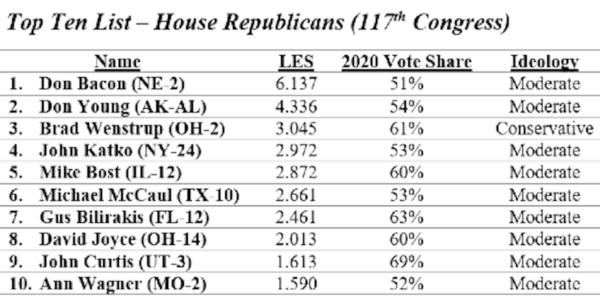
Turning to the Republican side of the aisle, the above table lists the most effective Republican lawmakers in the 117th House. It also shows the percentage of the vote that each of these lawmakers received in their 2020 elections to enter the 117th House, as well as whether they tend to be ideologically moderate or conservative in their voting patterns on the floor of the House, in comparison to other Republican members.
In contrast to the House average of winning 65% of the vote, only one of the top ten Republican lawmakers had a safer than average seat (Rep. John Curtis of Utah). Five of them won with less than 55% of the vote (including two members with 52% or less of the vote). This pattern is consistent with the previous Congress, when eight of the top ten Republicans came from at-risk districts. Perhaps these members focused on achieving lawmaking successes to aid in their reelection efforts. Indeed, in 2022, all of these at-risk top performers who sought reelection won (Rep. Don Young passed away while in office, and Rep. John Katko did not seek reelection). Recent research, however, suggests that lawmaking effectiveness is more beneficial in primary election contests than in the general election.
The ideology metric demonstrates that the overwhelming majority of the top 10 Republican lawmakers (nine out of ten) are more moderate than their party’s median member. Perhaps this ideological leaning, and the need to appeal to a divided constituency, led them to put forward proposals that resonated with Democrats in the majority. That said, the fact that a more conservative-leaning member, such as Rep. Brad Wenstrup of Ohio, is ranked as the third-most effective Republican lawmaker points to how conservative Representatives can be effective at lawmaking, even in a Democratic-controlled House. It is also worth noting that every one of the eight returning members from the Republican “top ten” list are members of the Republican Study Committee and/or the Republican Main Street Partnership. The fact that these caucus members were all among the most effective Republican lawmakers in the 117th Congress is likewise consistent with research that points to the enhanced lawmaking effectiveness of Representatives who belong to intraparty ideological caucuses when they are in the minority party.
At the top of the list, we see Rep. Don Bacon of Nebraska, who introduced 50 bills into the 117th Congress. On the surface, the fate of these bills appears limited, with only two of them passing the House, and only one of them (a post office naming) become law; however, a deeper consideration of his legislative agenda points to the impressive scope of his success. In particular, Rep. Bacon was able to effectively use the intricacies of the lawmaking process behind the scenes to move his proposals forward. Specifically, we are able to identify sixteen bills that Rep. Bacon introduced into the House that had their language substantially incorporated into other bills that ultimately became law. Examples of these bills include the Warrior Brain Health Act of 2022, the Department of Defense Law Enforcement Credential Act of 2022, the Military Energy Security Act of 2022, and eight other bills sponsored by Rep. Bacon that ultimately found their way into the James M. Inhofe National Defense Authorization Act for Fiscal Year 2023. Taken together, Rep. Bacon’s Legislative Effectiveness Score places him as the fourth overall in the House, despite being a member of the minority party. His approach, working behind the scenes to strike compromises and insert his bill language in other legislative vehicles, shows further opportunities for minority-party lawmakers to succeed in Congress.
Moving beyond Rep. Bacon, we see that Representatives Young, Katko, and McCaul, continued their trends of being among the “top 10” most effective Republican lawmakers. Consistent with past patterns, prior to his death in March of 2022, Rep. Young introduced numerous bills that engaged with matters pertaining to native Americans, and public lands and natural resources: key policy issues for his home state of Alaska. We can likewise see that many Republicans who are on our “top 10” list focused most of their legislative activity on one particular policy area, including Rep. Bost, who specialized in armed forces and national security, Rep. McCaul, who specialized in international affairs, and Rep. Bilirakis, who specialized in health policy. The fact that those with tightly tailored agendas were at the very top of our list is consistent with recent research on the lawmaking value of gaining expertise in Congress through specialization.
Highly Effective Democratic Lawmakers in the 117th Senate
The following table identifies the ten highest-scoring Democrats in the 117th Senate. As in the House, the list is largely (here, entirely) populated by those with chair positions, including committee chairs holding five of the top six spots. It is interesting to note how consistent the patterns of legislative success were across congresses, even with Democrats moving from the minority party in the 116th Congress to holding a bare majority in the 117th. Four of the top five Democrats in the 117th Congress and one additional Democrat (Sen. Merkley of Oregon) were in the top 10 in the 116th Congress, offering evidence that lawmaking skills translate well across institutional positions – from the minority party into the majority and even into committee chair positions.
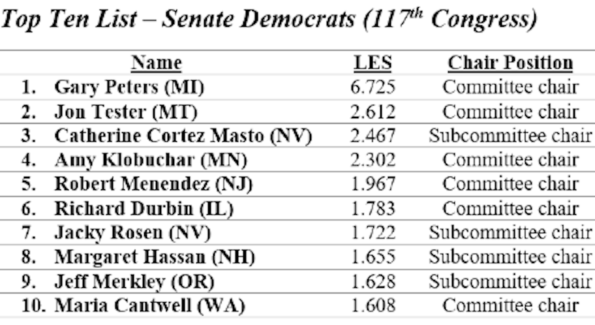
At the top of the list is Sen. Gary Peters, who in the 116th Congress had the rare distinction of being the overall most effective lawmaker in the Senate, despite Democrats being the minority party. As we noted previously, with the exception of the 107th Senate (2001-02), in which Senate control shifted partway through the term from Republican to Democratic when Senator Jim Jeffords switched parties, Sen. Peters’s feat cannot be found anywhere else in the Center for Effective Lawmaking data, which stretch back to the early 1970s. That he has emerged as the most effective lawmaker in the entire Senate once again demonstrates that his success in the 116th Congress was not a one-time aberration that was driven (perhaps) by the fact that Sen. Peters was engaged in a tough reelection battle in 2020. In the 117th Congress, he served as the chair of the Homeland Security and Government Affairs Committee; he introduced 102 bills, 43 of which engaged with matters directly related to government operations and emergency management. Given that such a large portion of his sponsored legislation fell under the jurisdiction of the committee that he chaired, it is perhaps unsurprising that he experienced so much lawmaking success: of the 102 bills that he introduced, 30 of them passed the Senate, and 19 ultimately became law.
Consistent with his past practice, Sen. Peters had at least one Republican cosponsor on each of his successful bills, with the exception of a bill that renamed a post office in Michigan (which was co-sponsored with his fellow Michigan Democratic Senator, Debbie Stabenow). Moreover, it was often the case that more Republicans than Democrats signed onto his bills as cosponsors. This pattern of cosponsorship aligns well with Center for Effective Lawmaking research showing that bipartisan lawmakers are much more effective than partisan lawmakers, even when in the majority party.
In addition, substantial portions of the language of another ten bills that Sen. Peters introduced were ultimately inserted into other legislators’ bills that became law, including the Cyber Response and Recovery Act of 2021, the Promoting Service in Transportation Act, the Motorcyclist Advisory Council Act of 2021, and the Furthering Advanced and Inclusive Research for Crash Tests Act, all of which were ultimately incorporated into the Infrastructure Investment and Jobs Act, which became law in November 2021.
Sen. Jon Tester of Montana was the second-most effective Democratic lawmaker in the Senate in the 117th Congress, where he was the chair of the Veterans’ Affairs Committee. During the 117th Congress, he sponsored 64 bills; and similar to Sen. Peters, Sen. Tester appeared to have pursued a specialization strategy, where the largest portion of his bills (33/64) engaged with one policy area: armed forces and national security. Moreover, we see that each of the six bills that he introduced that were ultimately signed into law, including the Ensuring the Best Schools for Veterans Act of 2022 and the Major Medical Facility Authorization Act of 2021, were referred to his committee of jurisdiction, where he was presumably able to use his position of influence to help them advance through the lawmaking process.
Sen. Catherine Cortez Masto (NV) continued to be the third-most effective Democratic lawmaker in the U.S. Senate in the 117th Congress, as she had been in the preceding Congress. In the 117th Congress, she was the chair of the Energy, Public Lands, Forests, and Mining Subcommittee of the Energy and Natural Resources Committee; and from this position she introduced 112 bills that touched on a diverse range of policy areas, including tax policy, energy, health policy, transportation, and others. Two of her bills ultimately became law, including the COPS Counseling Act, which set forth requirements for peer support counseling programs for law enforcement officers. Similar to Sen. Peters, Sen. Cortez Masto was also quite successful in having the language from her sponsored bills incorporated (in large parts) into other bills that became law. In her case, major portions from 10 of her sponsored bills were ultimately incorporated into new laws that had been sponsored by other legislators, including five of her bills that were incorporated into the Infrastructure Investment and Jobs Act.
The other committee chairs who round out the top-ten list were Senators Amy Klobuchar (Rules and Administration), Robert Menendez (Foreign Affairs), Richard Durbin (Judiciary), and Maria Cantwell (Commerce, Science, and Transportation). Together, these senators accounted for 14 new laws. Sen. Jacky Rosen chaired the Tourism, Trade and Export Promotion Subcommittee of the Commerce, Science, and Transportation Committee, and she successfully advanced two sponsored bills into law: one that provided for new grants to mobile health units, and the other that directed the FCC to collect and distribute data on maternal mortality in its health mapping tool. Sen. Margaret Hassan chaired the Emerging Threats and Spending Oversight Subcommittee of the Homeland Security and Government Affairs Committee. Nearly half of the 73 bills that she introduced into the 117th Congress engaged with matters pertaining to health, armed forces and national security, and/or government operations and politics, including the STANDUP Act of 2021, which directed the Department of Health and Human Services to give grant award preference to state, tribal, and local educational agencies that planned to implement evidence-based suicide awareness and prevention training policies.
Although women continue to be under-represented in Congress, seeing half of the top ten list for Democratic Senators comprised of women continues a long-standing pattern of women being particularly effective lawmakers in the Senate. That said, the list for Republican Senators below does not show a similar pattern.
Rounding out the list is Sen. Jeff Merkley, who was the chair of the Chemical Safety, Waste Management, Environmental Justice, and Regulatory Oversight Subcommittee of the Environment and Public Works Committee; he was successful in advancing two of his bills into law, while also managing to advance the language of three more of his sponsored bills within others’ bills that became law.
Highly Effective Republican Lawmakers in the 117th Senate
Turning to the Republican Senators in the 117th Congress, our top-ten list features interesting findings, both in terms of broad patterns, as well as in specific cases. First, it is notable that there is significant overlap between the top-ten list for the 117th Congress and the preceding top-10 list for Republican lawmakers in the 116th Congress, despite the fact that the Republicans became the minority party in the 117th Congress. More specifically Senators Cornyn, Rubio, Grassley, Murkowski, Wicker, and Moran all continued to appear among the top-10 most effective Republican lawmakers in the Senate, despite not holding the same institutional advantages (such as committee chairs) that might have contributed to their successes in the previous Congress. The fact that these senators are consistently among the most successful lawmakers in their parties across Congresses points to a commitment to navigating the legislative landscape to advance their agendas.
Second, it is worth noting that there is notable overlap between the Legislative Effectiveness Scores of the top Republican and Democratic lawmakers in the Senate, such that several of the top-10 most effective Republican lawmakers have higher Legislative Effectiveness Scores than the top-10 Democratic lawmakers, despite being in the minority party. For example, Sen. John Cornyn of Texas has a Legislative Effectiveness Score of 4.487, which actually makes him the second-most effective lawmaker in the Senate overall (behind Sen. Gary Peters). Similarly, Sen. Marco Rubio of Florida’s Legislative Effectiveness Score makes him the second-most effective Republican lawmaker in the Senate, and the third-most effective lawmaker in the Senate overall (with a score just slightly above that of Sen. Jon Tester). The overlap between the Legislative Effectiveness Scores of the top performers points to the ways in which the Senate continues to be a relatively bipartisan lawmaking institution, where members of both parties can successfully advance their legislative initiatives. Although, as the table illustrates, some of this bipartisan success may be attributed to Republican moderates scoring particularly well, examples such as conservative Sen. Rubio suggest the possibility of a successful lawmaking path for all members of the minority party.
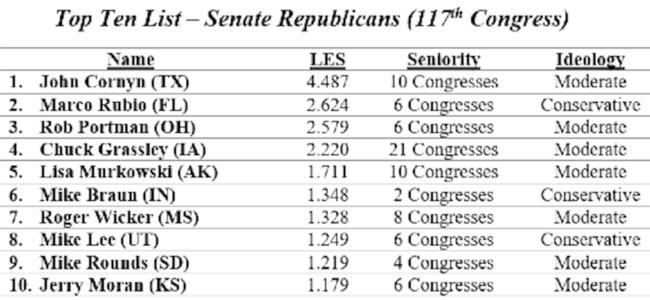
Turning more fully to the individual senators, Sen. John Cornyn tops the list, based on the 102 bills that he put forward, 23 of which passed the Senate, and 15 of which became law. While he introduced bills in many areas of public policy, a large portion of his legislative agenda engaged with matters pertaining to armed forces and national security, government operations, crime and law enforcement, and international affairs; and most of his bills that were ultimately signed into law fell into one of these categories, including the Law Enforcement De-Escalation Training Act of 2022, the Ukraine Democracy Defense Lend-Lease Act of 2022, the National Cybersecurity Preparedness Consortium Act of 2021, and the Supreme Court Police Parity Act of 2022.
Second on our top-10 list is Sen. Marco Rubio, who introduced 194 bills, 10 of which passed the Senate, and six of which ultimately became law. Although his legislative portfolio was quite wide-ranging, the largest portion of his sponsored bills engaged with matters pertaining to international affairs. As we noted in our previous discussion of effective lawmaking in the 116th Congress, Sen. Rubio’s success in advancing his legislative agenda has increased steadily over his time in Congress. In his first term in Congress (the 112th Congress), he sponsored only 17 bills, and he was among the less-effective lawmakers in his party. Since the 115th Congress, however, he has continued to be among the top-10 most effective lawmakers among Senate Republicans.
Sen. Chuck Grassley of Iowa is ranked number four among Republican lawmakers (and the eighth-most effective lawmaker in the Senate overall) in the 117th Congress. Despite no longer holding a committee chair (he was the Chair of the Senate Finance Committee in the 116th Congress), his policy agenda was quite focused, in that 23 of the 72 bills that he introduced engaged with matters pertaining to crime and law enforcement. Of the 72 bills that he introduced, 12 of them passed the Senate, and five became law (as well as having language from three more embedded within the laws sponsored by other legislators), including the Justice for Victims of War Crimes Act, the Trafficking Victims Prevention and Protection Reauthorization Act of 2022, and the Protecting America’s First Responders Act of 2021.
Sen. Lisa Murkowski is another senator who has consistently been ranked among the top-10 most effective Republican lawmakers in the Senate. In the 117th Congress she introduced 43 bills, nine of which passed the Senate, and four of which became law. Consistent with the legislative strategies of her fellow Alaskan, the late Rep. Don Young, Sen. Murkowski’s legislative portfolio dealt with many matters that were of direct relevance to Alaska, including policies regarding energy and natural resources, Native American affairs, and health policy. It is likewise worth noting that every bill that she sponsored that became law had direct ties to the state of Alaska and her constituents.
Rising onto our top-10 list, with the third-highest Legislative Effectiveness Score in the Republican Party, is Sen. Rob Portman of Ohio, who retired at the conclusion of the 117th Congress. During his final term in office, Sen. Portman introduced 83 bills, six of which passed the Senate, and one of which—the Early Hearing Detection and Intervention Act of 2022—became law. Sen. Portman also saw the language of eight of his sponsored bills being incorporated in large parts into other bills that became law, including the Make PPE in America Act, and the Federal Permitting Reform and Jobs Act; both of these were incorporated in large parts into the Infrastructure Investment and Jobs Act. Also new to our top-10 list is Sen. Mike Braun of Indiana, who first entered the Senate in the previous 116th Congress. Though relatively junior, Sen. Braun introduced 80 bills, 20 of which engaged with health policy. He ultimately saw four of his bills pass the Senate, and three of them become law. The other two recent newcomers to our top-10 list, Sen. Mike Lee of Utah and Sen. Mike Rounds of South Dakota, were both successful in seeing at least one of their sponsored bills become law during the 117th Congress.
Lawmakers with Long-Standing Patterns of Exceeding Expectations
Some members of Congress attain the status of being a top-ten lawmaker within their party quite infrequently, rising onto the list due to their position as a committee chair or as a Senator seeking legislative accomplishments prior to a tough election battle. For others, effective lawmaking is a way of life. As noted above, those who significantly exceed their benchmark score (which is calculated based on their seniority and status as a majority party member or chairperson) are identified as being in our “Exceeds Expectations” category.
Only about one quarter of lawmakers achieve the “exceeds expectations” rating in any given Congress. Those who are continuously members of this category are truly remarkable and worth watching. The lists below show those Representatives and Senators with the longest active streaks of exceeding expectations continuing through (and including) the 117th Congress. We see that both Republican and Democratic members of Congress are quite prolific lawmakers, despite differences in their ideological positions and their views about the appropriate scope of government activism.
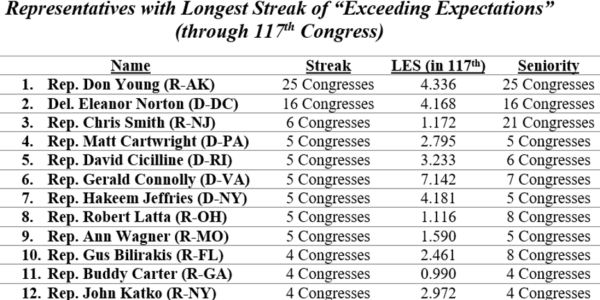
Continuing their streaks of being in the “Exceeds Expectations” category for each and every term of their decades-long congressional careers are the late Rep. Don Young of Alaska and Congresswoman Eleanor Holmes Norton of the District of Columbia. That both of these legislators have kept these streaks going both in the majority or minority party, both as rank-and-file lawmakers and as chairs at the committee or subcommittee level is truly remarkable. Both offer lessons for legislators who seek to become more effective lawmakers. And both are featured prominently in the CEL’s guide to effective lawmaking for newly-elected members of Congress.
Third on the House list is Rep. Chris Smith, who completed his 21st term in the 117th Congress. Consistent with his past practice in previous congresses, in the 117th Congress the largest portion of his bills engaged with matters of international affairs, but he was quite successful at advancing his legislative agenda in other areas, including Sami’s Law, which addressed safety requirements for passengers and drivers of ride-sharing companies, and was signed into law on January 5, 2023, two days after the conclusion of the 117th Congress.
Representatives Carter, Cartwright, Jeffries, Katko, and Wagner all continued their trend in effective lawmaking from previous congresses, such that they have all been in the “Exceeds Expectations” categories for their entire congressional careers. Representatives Cicilline, Latta, Bilirakis, and Carter have likewise all extended their streaks of effective lawmaking to at least four congresses with the conclusion of the 117th Congress.
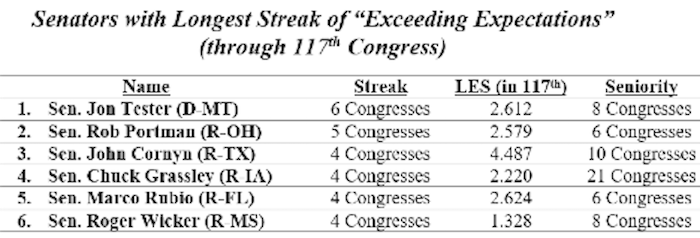
Turning to the Senate, two interesting findings emerge. First, the number of Senators with a four-or-more-Congress streak of “Exceeding Expectations” in lawmaking is three times the number of Senators who had this categorization in the 116th Congress (where only Sen. Tester and Sen. Portman had been categorized as “Exceeding Expectations” across at least four successive congresses). Second, it is likewise interesting that the six Senators who have been continuously effective lawmakers across congresses are mostly Republican, with the lone exception being Sen. Jon Tester of Montana. That five Republicans have continued their patterns of being highly effective lawmakers regardless of whether their party controls the chamber, and that four of them (following the retirement of Sen. Portman) have returned to the 118th Congress, speaks well to the prospects of continued effective lawmaking emerging from both sides of the aisle over the next two years.
High-Performing Freshmen
Another way to glean which Representatives and Senators are likely to be effective lawmakers in the current Congress is to consider the newly elected freshman members who scored in our “Exceeds Expectations” in their first term in office. Relative to the 26 legislators who exceeded expectations during their freshman term in the 116th Congress, the current list of ten is notably smaller. The list is also notable in that with the exception of the highest scoring freshman (Rep. Torres of New York), every freshman Representative who exceeded expectations in lawmaking effectiveness was a member of the (minority) Republican Party.
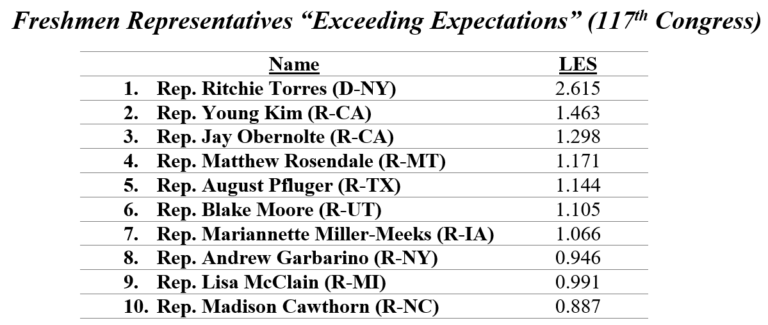
Every member on this list had at least one of their sponsored bills become law or at least had the language from one of their sponsored bills substantially incorporated into another measure that ultimately became law. Given that nine of these ten Representatives were reelected to the 117th Congress, and that research suggests that performance in a legislator’s freshman term is highly correlated with subsequent lawmaking effectiveness, as well as with their overall career trajectory, we might expect to see these Representatives continuing to be effective lawmakers and setting the Republican agenda in the future.

Turning to the Senate, we define “Freshmen” in a slightly different way. Here we refer to any of the 26 senators in their first six-year term during the 117th Congress. The average Legislative Effectiveness Score of these 26 senators was 0.91, with majority-party “freshmen” scoring 1.30, and minority-party “freshmen” having an average score of 0.51. Four of these 26 senators had Legislative Effectiveness Scores that “Exceeded Expectations,” with the top score being held by Sen. Cortez Masto of Nevada, who was also the third-most effective Democratic lawmaker in the Senate overall. The remaining three senators (Rosen, Hassan, and Braun) were likewise among the ten most effective lawmakers in the Democratic and Republican parties in the 117th Congress.
Most Successful Lawmakers at Having their Bill Language Attached to Others’ Laws
An innovation that the Center for Effective Lawmaking incorporated into the methodology to calculate the Legislative Effectiveness Scores for the 117th Congress was to give bill sponsors credit if large portions of their bills were ultimately incorporated into other bills that became law. Hence, we are able to identify those members of the House and Senate who were most successful at having their sponsored standalone bills substantially incorporated into the laws of other members of Congress, frequently as policy riders or “hitchhikers.” Several of these Representatives and Senators have already been discussed in other contexts above; a more expansive list of top performers in each chamber is presented below.
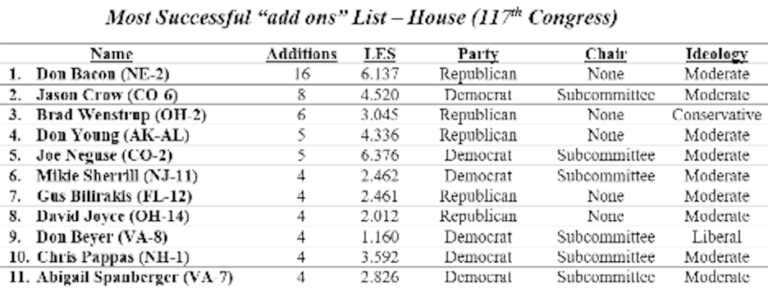
In looking across the lists of top performers, several points emerge. First, perhaps surprisingly for a period of unified government, the lists are quite bipartisan: both Republicans and Democrats in the House and the Senate are successful at having the language from their bills inserted into other vehicles that are ultimately passed and become law. Second, among majority-party members, all of the Representatives and Senators who are especially successful at having their language added to other bills are chairs of committees or subcommittees, which points to the well-known importance and influence of these roles in setting the legislative agenda in the House and the Senate. Third, it is notable that nearly all of the Representatives and Senators on these lists are relatively ideologically moderate, in comparison to other members of their parties, which points to how Representatives and Senators who are (relatively) centrist might find a pathway forward towards advancing their legislative agendas, even if they are not successful at seeing their sponsored bills advance in their standalone form.
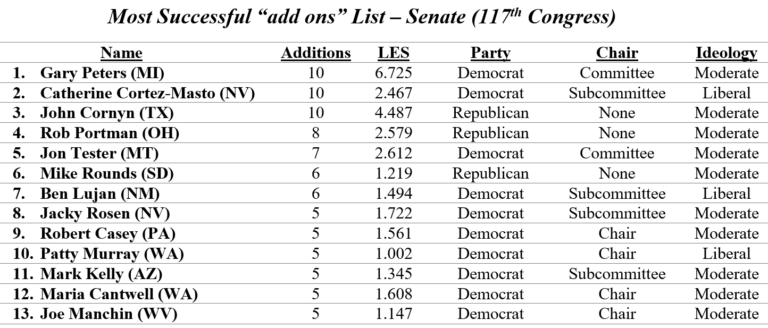
Finally, those Representatives and Senators who are most successful at having their language inserted into other bills tend to be those same Representatives and Senators who were most successful at having their sponsored bills move forward as standalone measures in the previous (116th) Congress. In other words, the most effective lawmakers at successfully advancing their own agenda items as standalone bills are also effective at working behind the scenes to have their legislative language inserted into other legislative vehicles that are moving into law.
Top Performers in the 117th House, by Policy Area
Similar to our presentation of the CEL Legislative Effectiveness Scores for the 116th Congress, we are also able to report Interest and Legislative Effectiveness Scores (ILES) in each of 21 different issue areas for the 117th Congress. These are based on issue area codes from the Comparative Agendas Project through the 111th Congress and based on issue areas found on www.congress.gov for the past decade. The methodology that we employed to construct these scores is the same as that for the overall LES; but we simply base our analysis on the subset of bills that each legislator sponsored in each issue area.
Throughout 2023 and 2024 we will be releasing reports in which we highlight the scores in many of these different issue areas. For now, we list the top performing lawmakers in each area, by party, for both the House and the Senate. Readers interested in exploring these scores more thoroughly can find all of these scores on the CEL website.
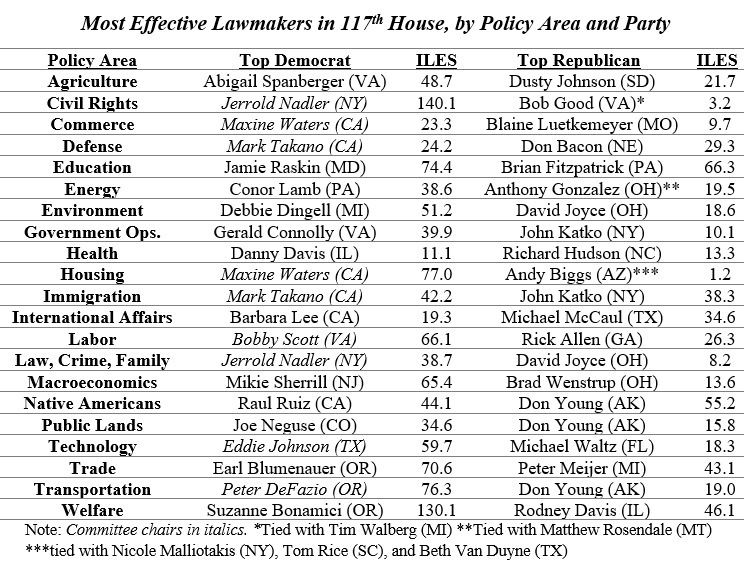
The table for top House performers across issue areas shows that several of these areas are dominated by committee chairs, for which these issue portfolios closely match the areas of their committee jurisdictions. For example, Rep. Jerrold Nadler chaired the Judiciary Committee and was the top Democratic performer in Law, Crime, and Family and Civil Rights, while Rep. Mark Takano, the Veterans’ Affairs Committee Chair, was the top performer on issues pertaining to Defense (which includes Veterans’ Affairs). In a similar vein, Rep. Bobby Scott was the Committee Chair of the Education and Labor Committee, and he was likewise the top performer in advancing legislation engaging with Labor policy.
Top performers on multiple issues among Republicans were the late Rep. Don Young on both Native Americans (where he outperformed the highest scoring Democratic lawmaker) and Public Lands issues, as he had been in the 116th Congress; and he was also the top performer on Transportation policy. Consistent with his activities in the preceding 116th Congress, in the 117th Congress, Rep. Michael McCaul outperformed all majority-party Democrats on International Affairs, an extremely rare accomplishment for a minority-party lawmaker. As one of the top-performing Republican lawmakers overall, he introduced 18 bills in the International Affairs area, with 6 passing the House, and one becoming law.
As we have noted in the past, in analyzing issue area success, we see that very high scores arise either from a truly remarkable performance in lawmaking by an individual in his or her chosen area, or because that area featured very little lawmaking activity across all members. Because each score is normalized to an average value of one, the total score of 454 in each issue area is spread across all of 454 members who proposed bills in the 117th House.
Also notable from these scores are the different priorities of Democrats and Republicans in their lawmaking endeavors. For example, Rep. Nadler’s score of 140 in Civil Rights far exceeds the performance of top Republicans in this issue area. Indeed, Nadler’s score exceeds all Republicans combined in this issue area. Likewise, the top Democrat far outpaced the top Republican in issues such as Housing, Transportation, and Welfare. In contrast, despite being in the minority party, the top performing Republicans held their own with Democrats in areas such as Education, Health, Defense, and International Affairs.
Top Performers in the 117th Senate, by Policy Area
Similar to the House, we see that committee chairs are prominently featured as top issue area performers in the Senate; and, again, we see that Senators’ successes in particular issue areas are frequently tied to their committees’ specified jurisdictions. For example, Sen. Gary Peters, Chair of the Senate Committee on Homeland Security and Government Affairs, led the Government Operations and Technology policy areas (both of which had clear ties to his committee).
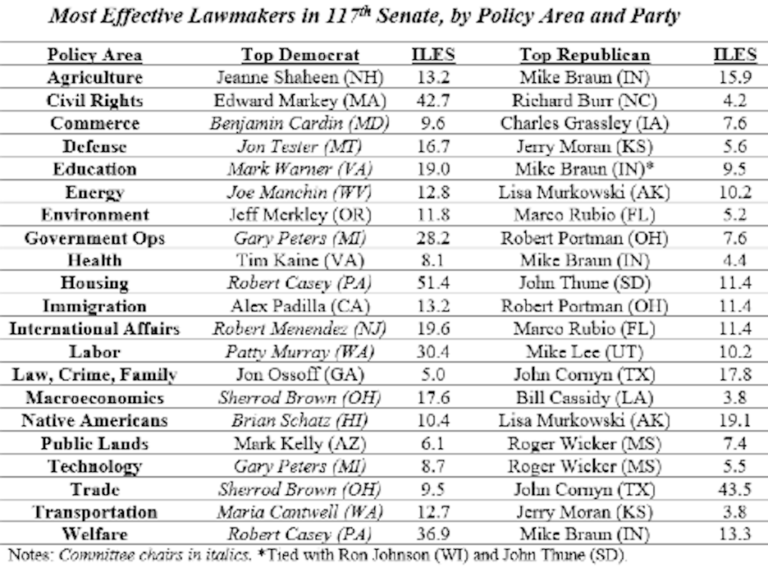
Among minority-party Republicans, Sen. Lisa Murkowski continued to be the top performer on Energy and on Native Americans among Republicans; and her score for Native Americans policy placed her as the top performer on this issue in the Senate overall, despite being in the minority party. Sen. John Cornyn, despite being in the minority party was likewise the most effective lawmaker on Trade policy and issues pertaining to Law, Crime, and Family. Finally, Sen. Mike Braun stands apart in being the top performer in Agriculture, Education (tied with Sen. Ron Johnson and Sen. John Thune), Health, and Welfare policies among Republicans; and he was the most effective lawmaker in the Senate for Agriculture policy overall.
Similar to in the House, we find that the top performing Democrat far exceeded the top performing Republican on a number of issues more commonly associated with Democrats, such as Civil Rights, Housing, Labor, and Welfare. On the whole, though, the patterns emerging here once again show active and effective lawmaking across numerous areas by both Democrats and Republicans, often engaging in bipartisan lawmaking, even if such activities are behind the scenes and not otherwise widely reported.



